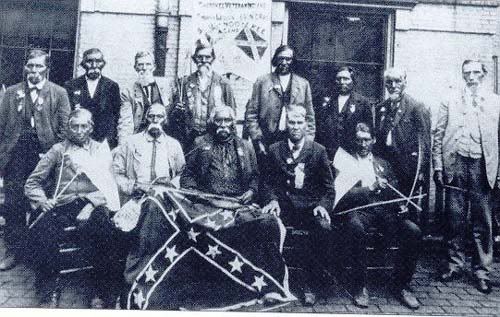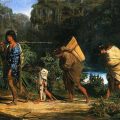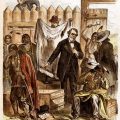
The Cherokees, whose traditional name is Aniyvwiya (Real People), were a farming people whose aboriginal homeland spread across 40,000 square miles in the American Southeast. Following the creation of the United States, there was pressure on the Cherokees to remove themselves or be forcibly removed from this valuable farming land and to settle west of the Mississippi River. In 1802, the federal government had promised Georgia that the Cherokees would be removed from the state. By 1819, some Cherokees had already left, seeking to establish new villages in Arkansas, Texas, and Mexico.
At the time of European contact, the Cherokee were divided into three broad groups: (1) the Lower Towns along the rivers in South Carolina, (2) the Upper or Overhill Towns in eastern Tennessee and northwestern North Carolina, (3) the Middle Towns which included the Valley Towns in southwestern North Carolina and northeastern Georgia and the Out Towns. There were some cultural and linguistic differences between these groups. Each town—perhaps 50 at the time of first European contact—was autonomous. The government of each town was not tied to the government of other towns.
In response to pressures from the United States and from the southern states, by 1819, the Cherokees had established a formal national council so that the Cherokees could deal with these foreign powers as a single nation rather than as independent, sovereign villages.
Briefly described below are some of the Cherokee events of 1819.
Cherokee Writing
Sequoia (also spelled Sequoyah), a monolingual Cherokee, developed a writing system for the Cherokee language. Many of Sequoia’s 85 characters were borrowed from the European alphabet, but the characters have phonetic values which are very different. Anthropologist Williard Walker, in his report on Native writing systems in the Handbook of North American Indians, notes:
“Sequoya was in no sense literate in any European language when he devised the syllabary.”
Anthropologist Charles Hudson, in his book The Southeastern Indians, writes:
“With great wisdom, Sequoyah realized that one of the most important advantages of the whites over the Indians was their ability to put their words down on paper.”
In developing Cherokee writing, Sequoyah let his farm go to waste, neglected his family, and was viewed as deviant in his behavior by Cherokee standards.
The Cherokee Visit Washington
In response to the Cherokee chiefs who visited Washington, D.C., the Niles Weekly Register reports:
“These chiefs, by their manners and deportment, exhibit a practical proof, to those who may have had doubts on that head, that the natives of this country only want the means of improvement to place them on an equality with the intelligent part of our citizens.”
The paper goes on to call for the “civilizing” of the Cherokee through a commitment to agriculture and Christianity.
Cherokee National Council
In Georgia, the Cherokee national council required citizens who operated stores or who sold sugar, coffee, salt, iron, and steel to purchase a $25 license. According to historian Theda Perdue (1991: 65):
“the system limited merchandising to those who had not only enough capital to set up shop but also enough cash to purchase a license.”
In Georgia, the Cherokee national council restricted non-Cherokee men to only one wife.
Removal, Relocation, Migration
In Arkansas, the Cherokees were told that they had settled on the wrong side of the Arkansas River. The U.S. government ordered them to move.
In Texas, a group of about 300 Cherokees under the leadership of Bowl established a settlement near the present-day city of Dallas. Bowl was angry at having been told to leave Arkansas and was seeking to escape the jurisdiction of the United States. Soon after the move, Richard Fields was chosen to replace Bowl as the principal leader.
In Arkansas, Western Cherokee leader Tahlonteskee died.
Religion
Cherokee peace chief Yonaguska died and cames back to life 24 hours later. He announced that he had gone to the spirit world where he talked with dead friends and relatives. In the spirit world, the Creator gave him a message to share with the people. As a result of this experience, Yonaguska organized a temperance society and banished whiskey from his followers.




Leave a Reply